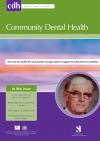Community Dental Health

- Cover Date:
- March 2012
- Print ISSN:
- 0265 539X
- Vol:
- 29
- Issue:
- 1
The use of occlusal indices in high-impact literature
doi:10.1922/CDH_2755ArcÃs04
Malocclusion is difficult to define because individuals and cultures vary widely in their perceptions of what constitutes an occlusal problem. A number of occlusal indices have been devised but, probably because of this perceptual problem, none has ever emerged as a standard. Objective: The main objective was to review the use of the principal occlusal indices. Basic research design: The PUBMED database was searched for the main occlusal indices employed, journals with an impact in dentistry and specialist orthodontics journals. Results: The occlusal indices most frequently employed were IOTN (163 studies), PAR (132 studies), DAI (68 studies) and ICON (32 studies). The journals publishing the greatest number of studies using these occlusal indices are those specialising in orthodontics. Conclusions: In the high-impact scientific literature, the indices in greatest use are IOTN, followed by PAR, DAI and ICON. DAI and IOTN are mainly used in epidemiological or prevalence studies, while PAR is generally used for longitudinal studies. IOTN is used more in Europe. DAI is used worldwide; though least in Europe.
Key words: occlusal indices, orthodontic treatment need, DAI, IOTN, ICON, PAR
- Article Price
- £15.00
- Institution Article Price
- £0.00
- Page Start
- 45
- Page End
- 48
- Authors
- C. Bellot-ArcÃ, J.M. Montiel-Company, J.M. Almerich-Silla, V. Paredes-Gallardo, J.L. GandÃa-Franco
Articles from this issue
- Title
- Pg. Start
- Pg. End
- The caries experience of 11 to 12 year-old children in Scotland and Wales and 12 year-olds in England in 2008-2009: Reports of co-ordinated surveys using BASCD methodology
- 8
- 13
- Variations in caries diagnoses and treatment recommendations and their impacts on the costs of oral health care
- 25
- 28
- Associated factors of tooth wear among Malaysian 16-year-olds: a case-control study in Kota Bharu, Kelantan
- 33
- 38
- Factors associated with self-assessed masticatory ability among community-dwelling elderly Japanese
- 39
- 44
- Development and testing of a theory-based behavioural change intervention: A pilot investigation in a nursery school in a deprived area of Scotland
- 62
- 67
- Illness-related behaviour and sociodemographic determinants of oral health care use in Dabou, Côte d’Ivoire
- 78
- 84
- Perception of oral health related quality of life (OHQoL-UK) among periodontal risk patients before and after periodontal therapy
- 90
- 94
- Dental Fluorosis, Dental Caries, and Quality of Life Factors among Schoolchildren in a Colombian Fluorotic Area
- 95
- 99
- Relationship of Periodontal Disease to Pre-term Low Birth Weight Infants in a Selected Population - A Prospective Study.
- 100
- 105
- Orofacial pain symptoms and associated disability and psychosocial impact in community-dwelling and institutionalized elderly in Hong Kong
- 110
- 116
- Association of hyposalivation with oral function, nutrition and oral health in community-dwelling elderly Thai
- 117
- 123
- Assessment of the relationship between perceptions of dental aesthetics and demand for orthodontic treatment in 10 – 11 year old school children in Birmingham, UK.
- 124
- 128
